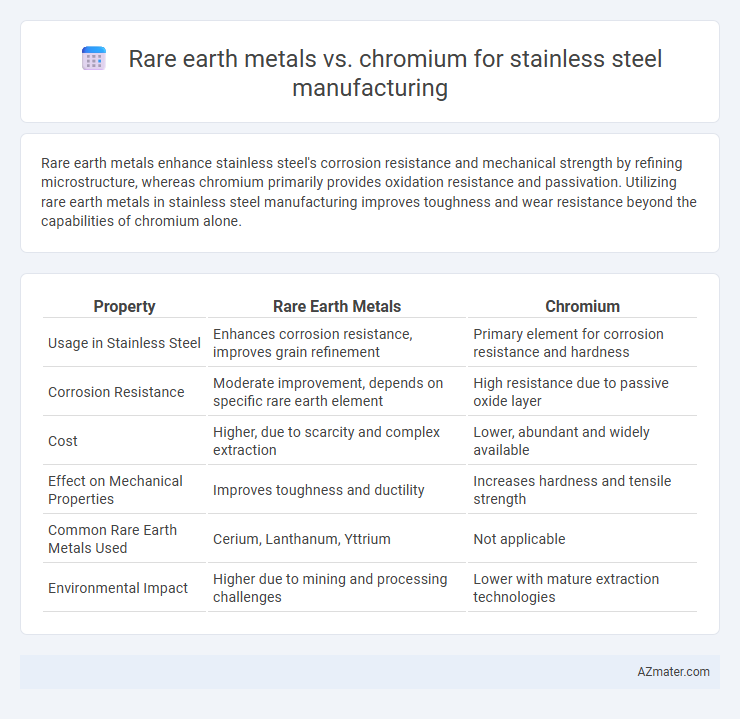Rare earth metals enhance stainless steel's corrosion resistance and mechanical strength by refining microstructure, whereas chromium primarily provides oxidation resistance and passivation. Utilizing rare earth metals in stainless steel manufacturing improves toughness and wear resistance beyond the capabilities of chromium alone.
Table of Comparison
| Property | Rare Earth Metals | Chromium |
|---|---|---|
| Usage in Stainless Steel | Enhances corrosion resistance, improves grain refinement | Primary element for corrosion resistance and hardness |
| Corrosion Resistance | Moderate improvement, depends on specific rare earth element | High resistance due to passive oxide layer |
| Cost | Higher, due to scarcity and complex extraction | Lower, abundant and widely available |
| Effect on Mechanical Properties | Improves toughness and ductility | Increases hardness and tensile strength |
| Common Rare Earth Metals Used | Cerium, Lanthanum, Yttrium | Not applicable |
| Environmental Impact | Higher due to mining and processing challenges | Lower with mature extraction technologies |
Introduction to Stainless Steel Manufacturing
Stainless steel manufacturing relies on alloying elements to enhance corrosion resistance, strength, and durability. Rare earth metals improve steel's oxidation resistance and refine grain structure, leading to better mechanical properties and weldability. Chromium, a key element in stainless steel, provides essential corrosion resistance and hardness, forming a passive oxide layer that protects the metal from rust and environmental degradation.
Overview of Rare Earth Metals
Rare earth metals play a crucial role in improving the machinability and corrosion resistance of stainless steel by refining grain structure and enhancing high-temperature strength. Unlike chromium, which primarily provides oxidation resistance and imparts the characteristic stainless quality, rare earth elements such as cerium, lanthanum, and yttrium act as grain refiners and inclusions modifiers. Their addition helps reduce sulfur-related defects and increases the steel's durability in harsh environments, making them indispensable for specialized stainless steel grades.
Chromium: The Traditional Alloying Element
Chromium remains the traditional alloying element in stainless steel manufacturing due to its exceptional corrosion resistance and ability to form a stable passive oxide layer. Its high melting point and hardness contribute to stainless steel's durability and resistance to oxidation under high temperatures. Compared to rare earth metals, chromium is more cost-effective and widely available, making it the backbone of stainless steel alloys worldwide.
Material Properties: Rare Earth Metals vs Chromium
Rare earth metals in stainless steel manufacturing enhance corrosion resistance, grain refinement, and toughness through microstructural stabilization, while chromium primarily provides excellent oxidation and corrosion resistance by forming a stable chromium oxide layer. Rare earth elements like cerium and lanthanum improve inclusion morphology and reduce sulfur-induced embrittlement, whereas chromium content (typically 10.5% or higher) is critical for maintaining the passive film essential for stainless steel's durability. The synergistic effect of rare earth metals and chromium optimizes mechanical strength and extends the lifespan of stainless steel in harsh environments.
Corrosion Resistance Comparison
Rare earth metals, particularly cerium and lanthanum, enhance stainless steel's corrosion resistance by refining the microstructure and improving oxide film stability. Chromium, a primary alloying element, forms a passive chromium oxide layer that provides excellent corrosion protection in various environments. While chromium primarily offers baseline corrosion resistance, rare earth metals optimize performance by reducing pitting and crevice corrosion tendencies in aggressive conditions.
Impact on Mechanical Strength
Rare earth metals enhance stainless steel's mechanical strength by refining grain structure and improving fatigue resistance, leading to better toughness and corrosion resistance under stress. Chromium primarily provides corrosion resistance and hardness but has a limited direct effect on mechanical strength compared to rare earth metal additions. Combining rare earth metals with chromium in stainless steel manufacturing results in a balanced microstructure that significantly boosts strength and durability.
Cost and Availability Factors
Rare earth metals, while enhancing corrosion resistance and durability in stainless steel manufacturing, tend to be significantly more expensive and less readily available than chromium, which is abundant and cost-effective. Chromium remains the primary alloying element due to its stable supply from large mining operations, ensuring consistent pricing and availability crucial for large-scale production. The supply chain volatility and geopolitical factors affecting rare earth metal markets increase costs and risks, making chromium the preferred choice for economical stainless steel manufacturing.
Environmental and Sustainability Considerations
Rare earth metals enhance stainless steel properties by improving corrosion resistance and durability, but their extraction involves significant environmental challenges such as habitat destruction and toxic waste generation. Chromium, a primary alloying element in stainless steel, is more abundant and its recycling reduces environmental impact while maintaining performance standards. Sustainable stainless steel production increasingly favors optimized chromium use alongside recycled rare earth metals to minimize ecological footprints and support long-term resource availability.
Industrial Applications and Case Studies
Rare earth metals enhance stainless steel manufacturing by improving corrosion resistance, mechanical strength, and high-temperature stability, making them critical in aerospace and chemical processing industries. Chromium content in stainless steel primarily provides oxidation resistance and durability, widely studied in industrial applications such as construction and automotive sectors. Case studies reveal rare earth elements like cerium and lanthanum reduce inclusions and improve weldability, outperforming traditional chromium-only alloys in demanding environments.
Future Trends in Stainless Steel Alloying
Rare earth metals are increasingly favored over chromium in stainless steel manufacturing due to their ability to enhance corrosion resistance and mechanical properties at lower alloying concentrations. Advances in metallurgical processes allow rare earth elements like cerium and lanthanum to improve grain refinement and reduce oxidation tendencies, contributing to more sustainable and cost-effective stainless steel production. Future trends indicate a shift towards optimizing rare earth metal content to achieve superior performance while addressing chromium supply constraints and environmental concerns.

Infographic: Rare earth metal vs Chromium for Stainless steel manufacturing
 azmater.com
azmater.com